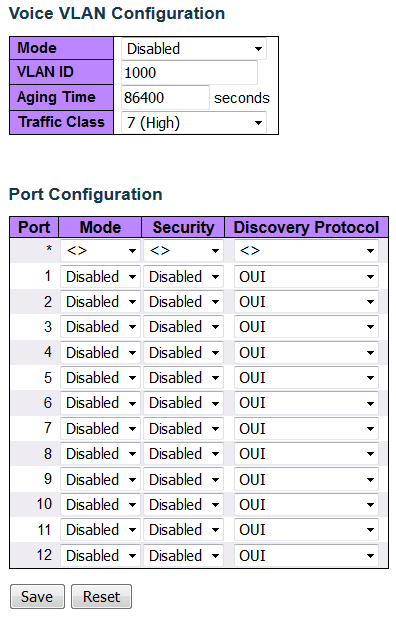Voice VLAN Configuration
The Voice VLAN feature enables voice traffic forwarding on the Voice VLAN, then the switch can classify and schedule network traffic. It is recommended that there be two VLANs on a port—one for voice, one for data. Before connecting the IP device to the switch, the IP phone should configure the voice VLAN ID correctly. It should be configured through its own GUI.

| Object | Description |
|---|---|
| Mode | Indicates the Voice VLAN mode operation. We must
disable MSTP feature before we enable Voice
VLAN. It can avoid the conflict of ingress filtering. Possible modes are:
|
| VLAN ID | Indicates the Voice VLAN ID. It should be a unique VLAN ID in the system and cannot equal each port PVID. It is a conflict in configuration if the value equals management VID, MVR VID, PVID etc. Valid range is 1 – 4095. |
| Aging Time | Indicates the Voice VLAN secure learning aging time. Valid range is 10 – 10000000 seconds. It is used when security mode or auto detect mode is enabled. In other cases, it will be based on hardware aging time. The actual aging time will be situated between the [age_time; 2 * age_time] interval. |
| Traffic Class | Indicates the Voice VLAN traffic class. All traffic on the Voice VLAN will apply this class. |
| Port Mode | Indicates the Voice VLAN port mode. Possible port modes are:
|
| Port Security | Indicates the Voice VLAN port security mode. When the function is enabled, all non-telephonic MAC addresses in the Voice VLAN will be blocked for 10 seconds. Possible port modes are:
|
| Port Discovery Protocol | Indicates the Voice VLAN port discovery protocol. It
will only work when auto detect mode is enabled. We should enable
LLDP feature before configuring discovery
protocol to “LLDP” or “Both”. Changing the discovery protocol to “OUI” or
“LLDP” will restart the auto-detect process. Possible discovery protocols are:
|
| Buttons | |
|---|---|
 |
Save changes. |
 |
Undo any changes and revert to previously saved values. |

